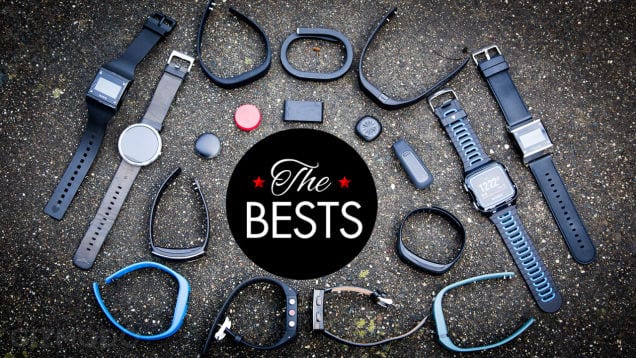In today’s society, the desire to be active and in shape is more prolific than ever before. And while we all know that it is not healthy to live a sedimentary lifestyle. It can sometimes be tough to fit exercise into an already full schedule. Oftentimes, we may need a bit of help when it comes to fitness. Thankfully, there are tools on the best fitness trackers to remind you and keep track of your fitness progress.
However, there are many different fitness trackers on the market today, and these devices vary greatly in their feature set and the types of metrics they will track. Take a look at the guide below to give you an idea about the various desirable features to look for when making a fitness tracker purchase.
Popular Metrics
Most fitness trackers will have an embedded accelerometer that will keep track of 3 things: steps taken, distance traveled, and calories burned.
This can be ideal for basic fitness tracking, but if your do more than just walking or jogging than it may be wise to invest it a tracker that has more sensors, such as:
Altimeters
Altimeter equipped trackers are able to log elevation statistics. This makes them ideal for those who do a lot of trail running (up and down hills) or who wear their tracker all day long and want to log any stairs they encounter.
Heart Rate Tracking
Many fitness trackers are now able to keep track of your heart rate. This sensor can give you a much better idea of your overall fitness levels, especially if you are someone who likes to exercise a lot.
There a few different types of heart rate monitoring fitness trackers but the most convenient type are of the optical variety. These are typically integrated into a wrist worn unit, eliminating the need for a bulky chest strap.
GPS
Smart watches (and some more expensive fitness trackers) will oftentimes have GPS sensors. If you do a lot outdoor exercise (such as biking or trail running) you should opt for a GPS enabled fitness tracker.
Having a device with GPS will allow you to better keep track of your exercise pace and distance. A GPS will also be handy for mapping out your route your fitness app.
Sleep Tracking
Keeping track of your sleeping patterns is often easier done with a dedicated device, however many fitness trackers can log your resting periods and movement during the night. If you have a tracker that does heart rate monitoring, you will also be able to log the different phases of your nights rest, such and light and REM sleep periods.
Ergonomics
Fitness trackers come in many designs and forms. There are fitness trackers that can be worn as a bracelet or anklet, while other are like clips that you hook to a part of your clothing. It’s up to you which you prefer.
However, if you would like to check your stats in real time, then you will need a fitness tracker that has a screen; and usually, the bracelet types excels at these.
There are also smart watch style fitness trackers that are highly detailed and can pair with many other types of sensors, such as power meters or standalone heart rate monitors.
Water Resistance
Most if not all fitness trackers are marketed as “splash proof”, since strenuous physical activities will oftentimes expose the tracker to liquids and moisture. Even if there is no water or rain, your sweat may seep-in into your fitness tracker and cause damage if it is not water resistant.
But if you are a swimmer and wish to fully submerge your fitness tracker, pay special attention to its “ATM” rating. ATM stands for atmospheric pressure and is a measure of how submersible your device is. Devices market 5 ATM or more are suitable for complete submersion up to 50 meters.
Apps
Most of the today’s fitness trackers come with an app that you can pair with the fitness tracker device.
The fitness tracker app can tremendously boost the usefulness of your fitness tracker. Hence, make sure that the app of your chosen fitness tracker is smooth, intuitive and easy-to-use. Also, more popular fitness trackers such as Fitbit will oftentimes have a web based application, which can make navigation much easier.
There are also many 3rd party apps that are fairly robust and have good support, such as Strava or Mapmyrun. However, many of the less expensive fitness trackers are not supported by theses apps.
Misfit Shine 2
The Shine is a small penny shaped fitness tracker than can be worn on a belt, as a necklace, or on the wrist. As far a tracking goes, the Shine is fairly basic. It only contains an accelerometer, which can keep track of your distance, pace, and calories burned.
However the Shine 2 is fully waterproof up to 5 ATM, and has a unique Led lighting system that can keep track of your current distance goal for the day. The Shine 2 is also able to notify you of a missed call when paired with your smart phone.
Jawbone UP4
Jawbones UP4 is a fitness tracker that you wear on your wrist. The cool part about Jawbone UP4 is that it doesn’t look like a fitness tracker. Rather, it resembles a fashion accessory. But don’t let its looks fool you – this fitness tracker is loaded with features.
The UP4 features a new type of heart monitor technology (known as ballistocardiography) that will keep track of your pulse throughout the day. The included app is also pretty decent, with its built in Smart Coach, which provides personalized tips and guidance.
Unique to the Jawbone UP4 is its enhanced sleep tracking, which is accurate enough track your deep sleep, light sleep and REM sleep.
And if that weren’t enough, the UP4 also features NFC technology that allows you to make wireless AMEX payments with the tap of your wrist.
Fitbit Charge HR
Fitbits Charge HR is another feature packed wrist style fitness tracker. This device is quite sporty and has a soft rubber style design. And it still manages to squeeze a screen in despite its low profile. The screen comes in handy since it allows you can check your heart rate in real-time. However, the Fitbit Charge HR is not limited to just heart rate monitoring. In addition to be able to track your steps, active minutes, floors climbed, calories burned, and distance, the device can also keep track of your individual workouts and has many preset routines that make for easy stat logging.
The HR will also automatically sync the data to your computer or mobile phone. This is useful for those who prefer a hands off experience when it comes to fitness tracking.
Garmin 920XT
This is a fitness tracker for those who are serious about their fitness. Garmins feature packed smart watch is a great tool for keeping track of your triathlon training, thanks to its dedicated Triathlon training mode and its ability to track open water swimming. You can also pair the device with any heart rate monitor via ANT+ or Bluetooth Smart for more accurate fitness tracking.
Garmin has also opted to include both a GPS and GlONASS (a Russian GPS system) module for more accurate position tracking. Lastly, you will also get the benefit of detailed sleep analysis and the ability to track 20 different activities, from running and cycling to wakeboarding and rowing.
Garmin Vivosmart HR
The Vivosmart HR is more if a fitness tracker/smart watch hybrid. And this is a good thing, as Garmin has seen fit to include many features only found on smart watches.
The HR is able to display activity intensity, floors climbed, heart rate, calories burned, distance and steps. It also is able to notify you by vibrating if your activity level is getting too low.
Lastly, the HR is also able to notify you if have social media messages, calendar alerts, emails, and even call and texts.
Conclusion
Getting fit is easier than ever before with the help of modern tools such as fitness trackers. When choosing a fitness tracker, make sure that your goals are in-line with the fitness tracker’s specialty. This has never been easier, thanks to the many different devices that have entered the market in recent years.
Author Bio:
I am a health and fitness enthusiast and I am currently training for my first triathlon. To help me keep better track of my goals, I often test out the latest wearable technologies. If you are looking to read similar content, take a look at my blog, which has many guides, including one on the best activity trackers.








